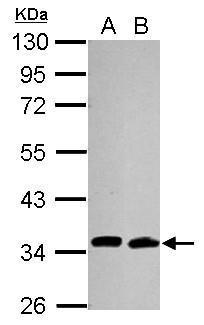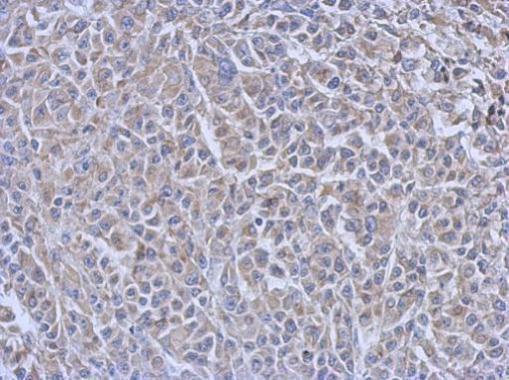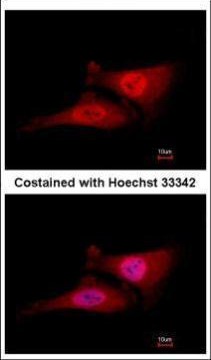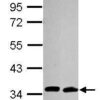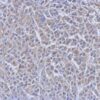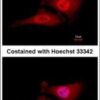Anti-cdc34 Antibody (56207)
$503.00
SKU: 56207
Categories: Antibody Products, Neuroscience and Signal Transduction Antibodies, Products
Overview
Product Name Anti-cdc34 Antibody (56207)
Description Anti-cdc34 Mouse Monoclonal Antibody
Target cdc34
Species Reactivity Human
Applications WB,ICC/IF,IHC-P,IP
Host Mouse
Clonality Monoclonal
Clone ID 14B5
Isotype IgG1
Immunogen N-terminus 6x-His tagged fusion protein encoding full-length human Cdc34 expressed in E. coli.
Properties
Form Liquid
Concentration Lot Specific
Formulation 10 mM PBS, pH 7.4.
Buffer Formulation Phosphate Buffered Saline
Buffer pH pH 7.4
Format Purified
Purification Purified by immunoaffinity chromatography
Specificity Information
Specificity This antibody recognizes human Cdc34.
Target Name Ubiquitin-conjugating enzyme E2 R1
Target ID cdc34
Uniprot ID P49427
Alternative Names EC 2.3.2.23,
Gene Name CDC34
Sequence Location Cytoplasm. Nucleus. Note=The phosphorylation of the C-terminal tail plays an important role in mediating nuclear localization. Colocalizes with beta-tubulin on mitotic spindles in anaphase.
Biological Function Accepts ubiquitin from the E1 complex and catalyzes its covalent attachment to other proteins. In vitro catalyzes 'Lys-48'-linked polyubiquitination (PubMed:22496338). Cooperates with the E2 UBCH5C and the SCF(FBXW11) E3 ligase complex for the polyubiquitination of NFKBIA leading to its subsequent proteasomal degradation. Performs ubiquitin chain elongation building ubiquitin chains from the UBE2D3-primed NFKBIA-linked ubiquitin. UBE2D3 acts as an initiator E2, priming the phosphorylated NFKBIA target at positions 'Lys-21' and/or 'Lys-22' with a monoubiquitin. Cooperates with the SCF(SKP2) E3 ligase complex to regulate cell proliferation through ubiquitination and degradation of MYBL2 and KIP1. Involved in ubiquitin conjugation and degradation of CREM isoform ICERIIgamma and ATF15 resulting in abrogation of ICERIIgamma- and ATF5-mediated repression of cAMP-induced transcription during both meiotic and mitotic cell cycles. Involved in the regulation of the cell cycle G2/M phase through its targeting of the WEE1 kinase for ubiquitination and degradation. Also involved in the degradation of beta-catenin. Is target of human herpes virus 1 protein ICP0, leading to ICP0-dependent dynamic interaction with proteasomes (PubMed:10329681, PubMed:10373550, PubMed:10871850, PubMed:11675391, PubMed:12037680, PubMed:15652359, PubMed:17461777, PubMed:17698585, PubMed:19112177, PubMed:19126550, PubMed:19945379, PubMed:20061386, PubMed:20347421). {PubMed:10329681, PubMed:10373550, PubMed:10871850, PubMed:11675391, PubMed:12037680, PubMed:15652359, PubMed:17461777, PubMed:17698585, PubMed:19112177, PubMed:19126550, PubMed:19945379, PubMed:20061386, PubMed:20347421, PubMed:22496338}.
Research Areas Neuroscience
Background Cdc 34 is a ubiquitin conjugating enzyme that is essential for the transition from G1 to S phase in Saccharomyces cerevisiae. Human Cdc34 fully complements the budding yeast Cdc34 temperature sensitive mutant phenotype. In extracts of Xenopus laevis eggs, Cdc34 is required for the onset of DNA replication and appears to function in a multi-protein complex. Cdc34 is highly conserved among vertebrates and probably functions similarly in all eukaryotes to regulate the start of DNA synthesis.
Application Images




Description Sample (30 ug of whole cell lysate)
A: A549
B: HCT116
10% SDS PAGE
56207 diluted at 1:1000
A: A549
B: HCT116
10% SDS PAGE
56207 diluted at 1:1000

Description Immunohistochemical analysis of paraffin-embedded HBL435 xenograft, using CDC34(56207) antibody at 1:200 dilution.

Description Immunofluorescence analysis of paraformaldehyde-fixed HeLa, using CDC34(56207) antibody at 1:100 dilution.
Handling
Storage This antibody is stable for at least one (1) year at -20°C. Avoid multiple freeze- thaw cycles.
Dilution Instructions Dilute in PBS or medium which is identical to that used in the assay system.
Application Instructions Immunoblotting and Immuno-precipitation: use at 1-5 ug/mL.
Positive controls: 293 cells and recombinant fusion protein.
Positive controls: 293 cells and recombinant fusion protein.
References & Data Sheet
Data Sheet  Download PDF Data Sheet
Download PDF Data Sheet
 Download PDF Data Sheet
Download PDF Data Sheet

